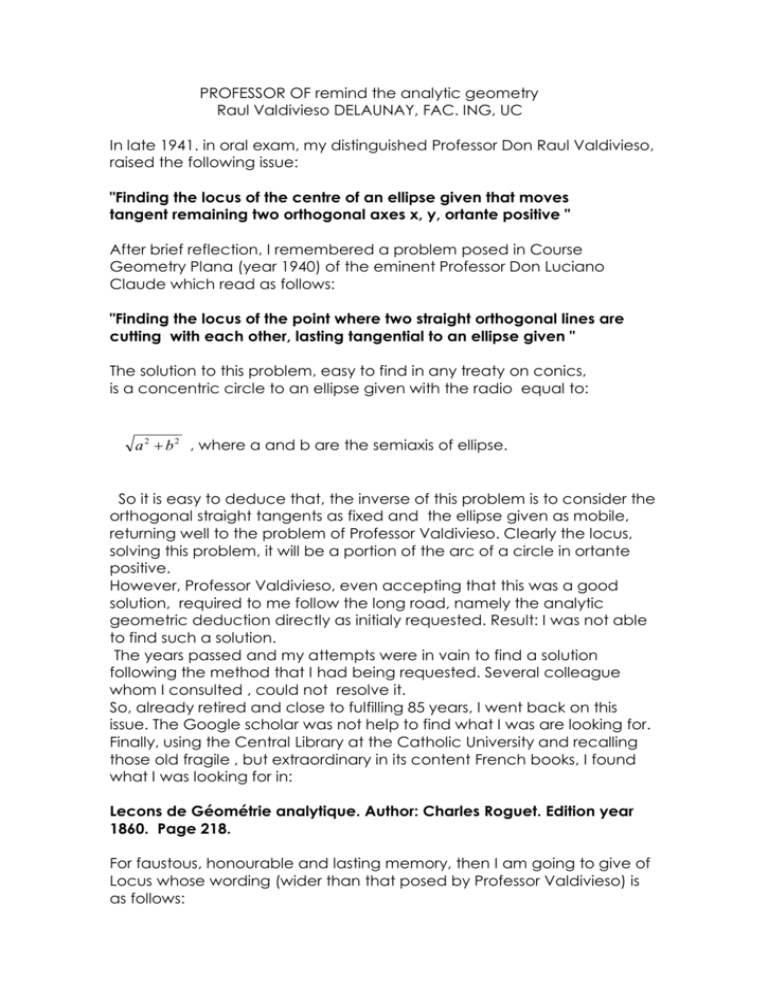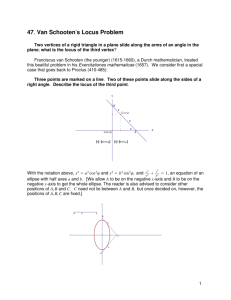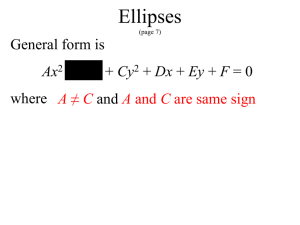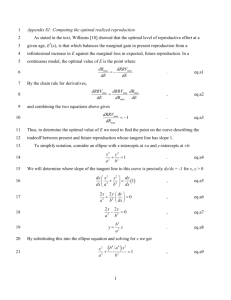Locus of an ellipse
advertisement

PROFESSOR OF remind the analytic geometry Raul Valdivieso DELAUNAY, FAC. ING, UC In late 1941. in oral exam, my distinguished Professor Don Raul Valdivieso, raised the following issue: "Finding the locus of the centre of an ellipse given that moves tangent remaining two orthogonal axes x, y, ortante positive " After brief reflection, I remembered a problem posed in Course Geometry Plana (year 1940) of the eminent Professor Don Luciano Claude which read as follows: "Finding the locus of the point where two straight orthogonal lines are cutting with each other, lasting tangential to an ellipse given " The solution to this problem, easy to find in any treaty on conics, is a concentric circle to an ellipse given with the radio equal to: a 2 b 2 , where a and b are the semiaxis of ellipse. So it is easy to deduce that, the inverse of this problem is to consider the orthogonal straight tangents as fixed and the ellipse given as mobile, returning well to the problem of Professor Valdivieso. Clearly the locus, solving this problem, it will be a portion of the arc of a circle in ortante positive. However, Professor Valdivieso, even accepting that this was a good solution, required to me follow the long road, namely the analytic geometric deduction directly as initialy requested. Result: I was not able to find such a solution. The years passed and my attempts were in vain to find a solution following the method that I had being requested. Several colleague whom I consulted , could not resolve it. So, already retired and close to fulfilling 85 years, I went back on this issue. The Google scholar was not help to find what I was are looking for. Finally, using the Central Library at the Catholic University and recalling those old fragile , but extraordinary in its content French books, I found what I was looking for in: Lecons de Géométrie analytique. Author: Charles Roguet. Edition year 1860. Page 218. For faustous, honourable and lasting memory, then I am going to give of Locus whose wording (wider than that posed by Professor Valdivieso) is as follows: “Trouver le lieu d´un point quelconque lié invariablement á une ellipse donnée, qui se meut en restant tangente deux droites rectangulieres données” We need to resolve the previously stated locus,to develop: SECTION A) the equation of an tangent line to the ellipse and SECTION B) The equation of the distance from a given point to a given straight line. SECTION A) Consider then the equations of tangents to an ellipse given that they are perpendicular to each other. if y=mx + n, is the equation of a secant to the ellipse, with m= as secant and n = ordinate at the intersection of the line with the axis y. If one imagines that this secant, remaining parallel to itsef, moves herself, and so that the two points of intersection with the curve are close to each other indefinitely, it is clear that at the limit, the secant will be tangent. Therefore,for y= mx+n representing a tangent is necessary and sufficient that it have a common solution with the equation: a 2 y 2 b 2 x 2 a 2 b 2 of the ellipse. This is equivalent to saying that the equation resulting from the elimination of y equations between the two precedents equations, namely: (a 2 m 2 b 2 ) x 2 2a 2 mnx a 2( (n 2 b 2) 0. must have two equal roots. Expressing this condition results: a 4 m 2 n 2 a 2 (m 2 b 2 )(a 2 m 2 b 2 ) where it obtain n a 2 m 2 b 2 Replacing the equation of the line y=mx+n equations obtain two parallel tangents to the given ellipse : y mx a 2 m 2 b 2 (1) y mx a 2 m 2 b 2 (2) The perpendicular to the first of these equations is: 1 a2 y x b2 (3) 2 m b These equations and the ellipse are referred to as coordinate axes, to the proper axis of the ellipse. Let' see now SECTION B) Distance from a given point to a given straight line Often we express the distance from one point to a line in terms of factors in the equation of the line. To do this, we compare two forms of the equation of a line, as follows: General Equation: Ax + By + C = 0 Normal Form: The general equation and the normal form represent the same line. Hence A , coefficient x in general equation, is proportional to cos coefficient of x in the normal way. By the same token, B is proportional to sen , and C is proportional to –p. Calling k the constant of proportionality, obtain: Raising the square and then adding obtain: The coefficients in the normal way, expressed in terms of A, B and C are as follows: The sing of is chosen so that p (Distance) is always positive. The conversion formulas developed above are used to find distance from one point to a line. Call p the distance from the origin to the line LK (See illustration). To find, d, the distance from the point P the straight LK,we build a line Figure 1. Distance from one point to a line across P, parallel to LK. The distance of this straight from the origen is OS, and the difference between OS and P is d We get an expression for d, based on the coordinates of P, as follows: and Returning to expressions for sen , coseno and p in terms of A,B, and C (Coefficients of the general equation), we have: The formula for d,the denominator in each of the expressions is the same. Therefore we can combine terms, as follows: The formula for d, denominator in each of the expressions is the same. Therefore we can combine terms, as follows: Now, apply this formula to the equations (1) and (3) to establish the distances from the point ( X 1 , Y1 ) matching corresponding coeficients. The result is: Y1 mX 1 a 2 m 2 b 2 m2 1 mY1 X 1 a 2 m 2 b 2 m2 1 In addition, these distances are nothing that coordinates the same point, the relatively to the straight lines taken as axis, then one can write: X= Y= Y1 mX 1 a 2 m 2 b 2 m2 1 mY1 X 1 a 2 m 2 b 2 m2 1 , Removing m among these equations will provide a new equation that expressed a constant relationship between the coordinates of any point of locus requested; this equation is then the locus we are looking for: In particular, if one wants to see the locus described by the center of the ellipse mobile, is necessary make: X 1 0, Y1 0 and find: a 2m2 b2 , y= a 2 m 2b 2 , removing m is done immediately, taking m2 1 m2 1 the square of precedents equations and adding immediately. The result is: x y 2 x 2 a 2 b 2 equation of a circle,into which is inserted the arch which is the locus sought; radius of that circle is: a2 b2 That was it. To this day I can not explain that Professor Raul Valdivieso expected that any students could develop this problem, in an examination or in any other circumstance, this problem. It is not that there is a much simpler solution? . I venture to think that has to be one,because the distinguished professor was very demanding but very thoughtful and fair. Raúl, Civil Engineer ,Pontificia Universidad Católica de Chile.










